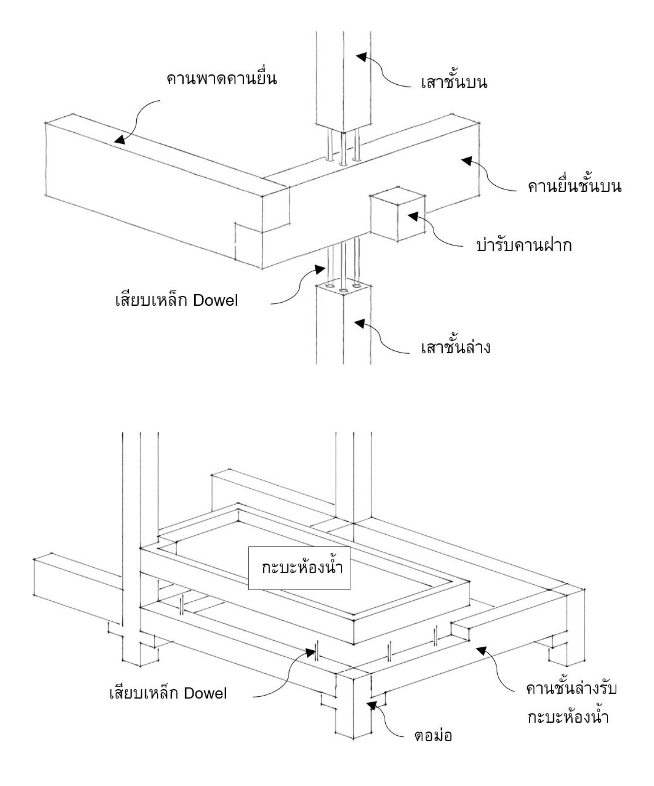Guidelines for Integration of Prefabrication Construction Technology for 2 – Storey Residential Building Design and Construction
Main Article Content
Abstract
This research focuses on studying the suitability of integrated prefabricated construction systems in Thailand by collecting quantitative and qualitative data through the expert interviews with project developers, architects and construction engineers from 3 project case studies. The main parameters studied for the integration of prefabricated construction systems include time, cost and quality of construction. The study found that four most used systems for slab construction include precast floor slab, corrugated plank, cast-in-place slab (on ground), and cast-in-place slab (on beam). For stair construction, three most used systems include precast concrete stair, cast-in-place stair, and steel stair. For wall construction, three most used systems include precast concrete wall, aerated concrete block, and light-frame wall. From this study, the factors that affect integration of prefabricated construction systems according to level of importance are installation of prefabricated parts, long-term use, installation time of joints, labor costs, service load, weight of prefabricated parts, quality of joints in construction, material and equipment costs, respectively.
Downloads
Article Details

This work is licensed under a Creative Commons Attribution-NonCommercial-NoDerivatives 4.0 International License.
All material is licensed under the terms of the Creative Commons Attribution 4.0 International (CC-BY-NC-ND 4.0) License, unless otherwise stated. As such, authors are free to share, copy, and redistribute the material in any medium or format. The authors must give appropriate credit, provide a link to the license, and indicate if changes were made. The authors may do so in any reasonable manner, but not in any way that suggests the licensor endorses you or your use. The authors may not use the material for commercial purposes. If the authors remix, transform, or build upon the material, they may not distribute the modified material, unless permission is obtained from JARS. Final, accepted versions of the paper may be posted on third party repositories, provided appropriate acknowledgement to the original source is clearly noted.
References
Boafo, F., Kim, J. H. & Kim, J. T. (2016). Performance of Modular Prefabricated Architecture: Case Study-Based Review and Future Pathways. Kongju National University, Cheonan, Korea. Retrieved from https://researchgate.net/publication/304005631_Performance_of_Modular_Prefabricated_Architecture_Case_Study-Based_Review_and_Future_Pathways.
Economic Intelligence Center (EIC). (2018). Construction Technology. Retrieved October 18, 2018 from http://nationweekend.com/news/15460.
Hong, X., Shoujian, Z., Yikun, S. & Zezhou, W. (2017). Factors Affecting the Capital Cost of Prefabrication – A Case Study of China. Harbin Institute of Technology, China. Retrieved from https://researchgate.net/publication/319282917_Factors_Affecting_the_Capital_Cost_of_Prefabrication-A_Case_Study_of_China.
Ina-ram, W. (2009). A Comparative Study on Two-Story House Construction Processes Using the Conventional System, Prefabricated Post and Beam System and Wall Bearing System: A Case Study of Perfect Park, Nonthaburi Province (Master’s Thesis). Faculty of Architecture, Chulalongkorn University, Thailand.
Jiradamkerng, W. (2001). Construction Planning and Scheduling. Bangkok, Thailand: Wankawee Publisher.
King Mongkut’s Institute of Technology Ladkrabang (KMITL). (2005). Design of R.C Prefabricated-Concrete System for 2 Storey Building Program. The National Housing Authority, Thailand. Retrieved from https://precast.rmutl.ac.th/.
Likert, R. A. (1961). New Patterns of Management. New York: McGraw-Hill Book Company Inc.
Raksakul, C. (2017). Prefabricated Construction: Detached House (Master’s Thesis). Faculty of Architecture, Chulalongkorn University, Thailand.
Rippon, J. (2011). The Benefits and Limitations of Prefabricated Home Manufacturing in North America. Faculty of Forestry, America. Retrieved from https://open.library.ubc.ca/cIRcle/collections/undergraduateresearch/52966/items/1.0103127.
Rujirakaphiruk, K. (2007). Assessment of Semi-Prefabrication Aur-Arthorn Project (Master’s Thesis). Faculty of Architecture, Chulalongkorn University, Thailand.
Shahzad, W., Mbachu, J. & Domingo, N. (2014). Prefab Content Versus Cost and Time Savings in Construction Projects: A Regression Analysis. In Proceedings of the 4th New Zealand Built Environment Research Symposium. Auckland, New Zealand. Retrieved from https://nzbers.massey.ac.nz/wp-content/uploads/2019/08/NZBERS-2014_proc_fp_Shahzad-W.pdf.
Watanasinsak, S. (2013). A comparison between precast construction and traditional construction for the improvement in the innovation of real estate’s construction (Master’s Thesis). Institute of Engineering, Suranaree University of Technology, Thailand.

